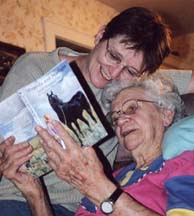In my last post, I talked about point of view, particulary, third person limited subjective POV, where the reader views the story only through the senses of one character. Another effective method, when done well, is to write from the omniscient viewpoint. The point of view is not that of a character in the story, but of an unseen other, usually the author, who tells the reader everything that is in the history, hearts and minds, of all the characters or a certain few of the characters in the book.
George Eliot used this technique in her book, Middlemarch. So did Lemony Snicket in his "Series of Unfortunate Events." Rather than losing the reader with too much switching between characters as writing from multiple viewpoints can do, this technique makes the reader feel included. The author or whatever omnicient narrator is telling the story, is confiding in you, the reader, and you feel privileged, somehow, to have this god-like knowledge shared with you.
The first book of Lemony Snicket's series, "The Bad Beginning," begins in a most unusual way, speaking directly to you, the reader, as if he cares deeply about your well-being.
"If you are interested in stories with happy endings," he says, "you would be better off reading some other book. In this book, not only is there no happy ending, there is no happy beginning, and very few happy things in the middle."
This conversational style from the omniscient narrator's POV continues throughout the book, telling you what is happening in the lives, minds, and emotions of the three Baudelaire children, as only an all-seeing god would be able to do.
I have not used this approach in any of my novels, but find it a very fun and intimate style to read.
Let me know what you think? What is your favorite POV style to read?
Friday, October 28, 2011
Subscribe to:
Posts (Atom)

